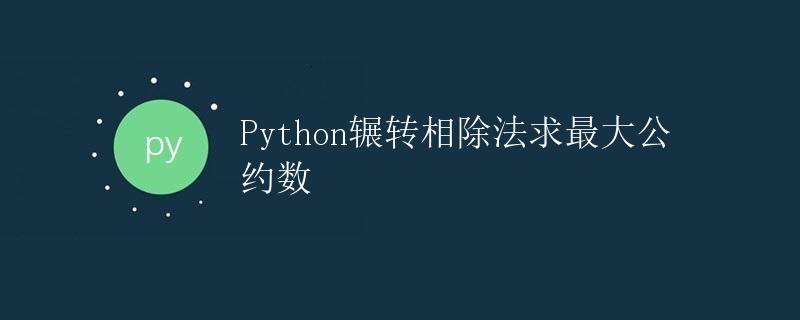Python Euclidean algorithm to find the greatest common divisor
Python Euclidean Algorithm for Finding the Greatest Common Divisor

Introduction
The Greatest Common Divisor (GCD) is the largest positive integer that can divide two or more integers simultaneously. Finding the greatest common divisor is frequently used in mathematical operations, particularly in simplifying fractions and finding the simplest integer. Python provides multiple methods for finding the greatest common divisor, among which the Euclidean algorithm is a common, simple, and efficient method.
This article will provide a detailed introduction to the Euclidean algorithm in Python, along with example code and runtime results.
Euclidean Algorithm
The Euclidean algorithm, also known as the Euclidean algorithm, is an effective method for finding the greatest common divisor. The basic idea is to use the division operation of two integers, repeatedly dividing the larger number by the smaller number, and then dividing the smaller number by the remainder until the remainder is zero. At this point, the smaller number is the greatest common divisor.
Euclidean Algorithm Implementation
Python has a built-in function for finding the greatest common divisor, math.gcd(), which can be called directly to calculate the greatest common divisor. However, to better understand the principles and implementation of the Euclidean algorithm, we can write a function to implement it ourselves.
The following is a Python function that uses the Euclidean algorithm to find the greatest common divisor:
def gcd(a, b):
while b != 0:
a, b = b, a % b
return a
- Parameters
aandbrepresent two integers; - Use a
whileloop to execute the loop body whilebis not equal to 0; - Within the loop body, use
a, b = b, a % <code>aandbare swapped, andbis updated to the remainder of dividingabyb. - This loop continues until
bis 0, at which point the value ofais the greatest common divisor.
Euclidean Algorithm Examples
The following examples demonstrate the use of the Euclidean algorithm.
Example 1: Finding the Greatest Common Divisor
Suppose we want to find the greatest common divisor of the integers a=24 and b=36. The idea behind using the Euclidean algorithm is as follows:
- Divide
abyb, yielding a quotient of 2 and a remainder of 6; - Divide
bby the remainder of 6, yielding a quotient of 3 and a remainder of 0; - When the remainder is 0, the loop ends, and the greatest common divisor is 6.
The following is a code example:
a = 24
b = 36
result = gcd(a, b)
print("Greatest common divisor:", result)
Running result:
Greatest common divisor: 12
Example 2: Finding the Greatest Common Divisor of Large Integers
The Euclidean algorithm maintains high efficiency when calculating the greatest common divisor of large integers. Let’s find the greatest common divisor of two large integers, a and b.
a = 1234567890123456789
b = 9876543210987654321
result = gcd(a, b)
print("Greatest Common Divisor:", result)
Running result:
Greatest Common Divisor: 9
Time Complexity Analysis of the Euclidean Algorithm
The time complexity of the Euclidean algorithm depends primarily on the smaller of the two integers. Let m be the smaller number and n be the larger number. The time complexity of the Euclidean algorithm can be approximated as O(log(m)). The Euclidean algorithm is relatively efficient, and finding the greatest common divisor for a typical data set does not incur significant time overhead.
Summary
This article introduced the Euclidean algorithm in Python in detail, providing implementation code and example results. The Euclidean algorithm is a common method for finding the greatest common divisor, frequently used in mathematical calculations and programming. By understanding the principles and implementation of the Euclidean algorithm, we can more easily find the greatest common divisor in Python and improve coding efficiency.